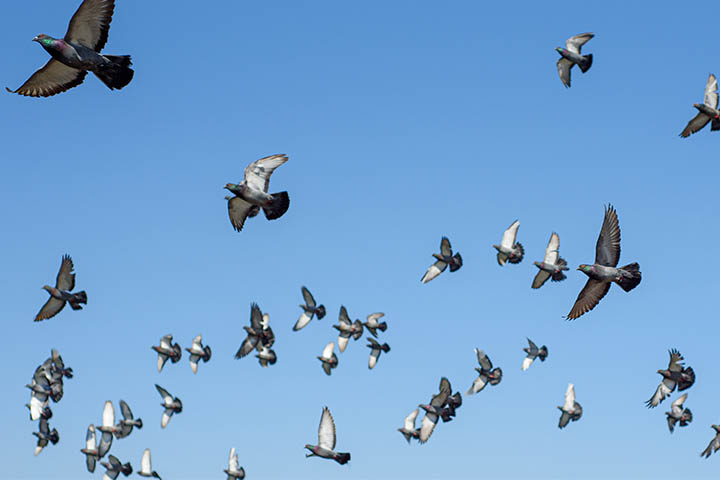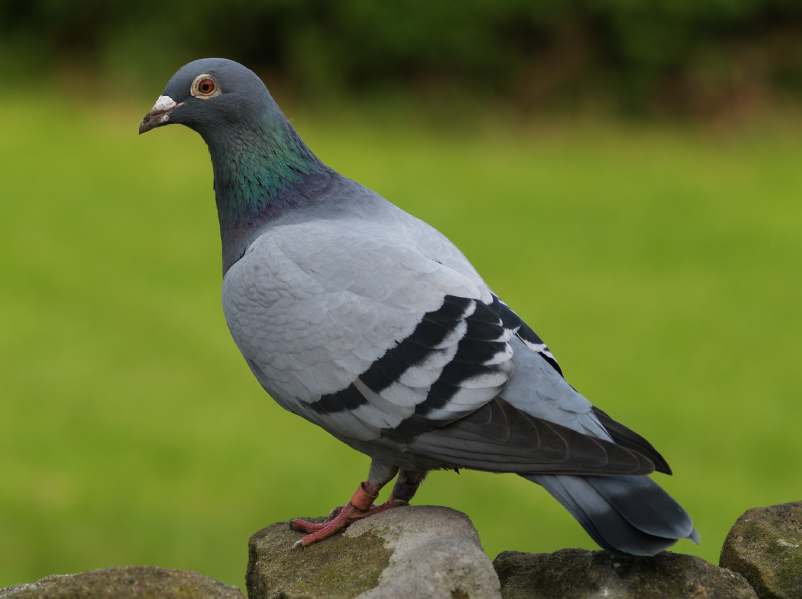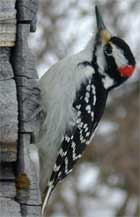Birds
Did you know? There are almost 9,000 species of bird in the world.

Explore Birds
Facts about Birds for Kids
Birds are feathered, winged, egg-laying vertebrates. They spend most of their day gathering food to support their fast metabolism. Some birds eat a variety of foods while others prefer seeds, insects and worms. A few types of birds migrate far distances at certain times of the year, flying at night and feeding during the day.
Keep reading to find kid-friendly facts about birds like pigeons, starlings, and woodpeckers.

Pigeons
Pigeons are also known as "rock doves". They are monogamous and will lay one to two eggs that hatch within eighteen days. See below for more information about pigeons for kids.
- Size: Up to 11"
- Color: Grey, white and black
- Legs: 2
- Wings: Yes
- Antenna: No
- Common Name: Pigeon
- Kingdom: Animalia
- Phylum: Chordata
- Class: Aves
- Order: Columbiformes
- Family: Columbidae
- Species: Columba livia
Diet:
Baby pigeons eat food that their parents eat and then regurgitate (throw up). Adult pigeons eat almost any organic food they can find.
Habitat:
Pigeons build nests around farms, warehouses, mills and grain storage. They also inhabit parks, buildings and bridges in cities.
Impact:
Pigeons are very dirty because they do not really clean themselves and they will live almost anywhere, under almost any conditions. They can cause food poisoning and spread disease such as cryptococcosis, histoplasmosis, toxoplasmosis, salmonella. Their droppings can destroy buildings and statues. Other pests like fleas, lice, mites and ticks that also spread disease may live on these birds.
Prevention:
- Make it hard for pigeons to build a nest.
- Fill in any holes in your house and don’t leave a lot of open space on flat surfaces where they might be able to build a nest.
- Keep all food and water out of their reach. Don’t leave garbage laying around, do not leave food out, keep birdbaths clean and do not litter.
- Do not feed the pigeons!
Find information for kids and teachers alike on pigeons at the official NPMA website.

Starlings
European Starlings were introduced in New York over a hundred years ago. These birds may produce two groups of offspring per year, each with four to seven babies.
- Size: About 6"
- Color: Dark with light spectacles on feathers
- Legs: 2
- Wings: Yes
- Antenna: No
- Common Name: Starling or European Starling
- Kingdom: Animalia
- Phylum: Chordata
- Class: Aves
- Order: Passeriformes
- Family: Sturnidae
- Species: Sturnus vulgaris
Diet:
Starlings love seeds but in the spring and summer they look for baby insects (grubs). Another interesting starling fact for kids is that they will forage in open trash containers and will eat spilled food in parks and picnic sites.
Habitat:
Starlings can be found anywhere from farms to cities. They usually travel in flocks and graze in short grass. They also build nests in trees or in gutters.
Impact:
Starlings will nest in trees and eat fruit, making them a big problem for fruit farmers. Their droppings may weaken steel and lead to structural damage. When their droppings get on the ground, fungus grows and can lead to diseases such as histoplasmosis. Starlings are also known for flying into airplanes, occasionally causing them to crash.
Prevention:
- Seal openings in your house so the Starlings cannot build their nests there.
- Trim trees and keep gutters clean. Loud noises also make them go away.
Parents and kids can find more facts about and information on starlings at the official NPMA website.

Woodpeckers
There are 21 species of Woodpeckers in the United States. These birds are federally protected and cannot be destroyed. These birds can have two or three broods per year, each with three to six babies.
Woodpeckers have an extra-thick skull, so they do not get a headache from all that pecking!
- Size: 7-15"
- Color: Red, black and white
- Legs: 2
- Wings: Yes
- Antenna: No
- Common Name: Woodpecker
- Kingdom: Animalia
- Phylum: Chordata
- Class: Aves
- Order: Piciformes
- Family: Picidae
- Species: Varies
Diet:
Woodpeckers eat insects found in trees. When they hear an insect under the bark, they peck a hole with their beaks. Their beaks are long, straight and pointy, good for making holes. Their tongues are really long with a sharp end for sticking bugs inside the tree. Their tongue is also sticky, so it can attach to ants in the tree or lick up sap. They also collect nuts and berries to eat and will sometimes eat peanut butter from bird feeders.
Habitat:
Woodpeckers usually live in or near trees. They can also nest in buildings, fences and large poles.
Impact:
Damaged caused by woodpeckers can range from holes in wood to damaged siding and air conditioning units.
Prevention:
- Most people just use noise to scare woodpeckers away from their homes.
- Remember, woodpeckers are Federally protected so any prevention or control must follow Federal laws.
You can find more woodpecker facts for kids at the official NPMA website.

